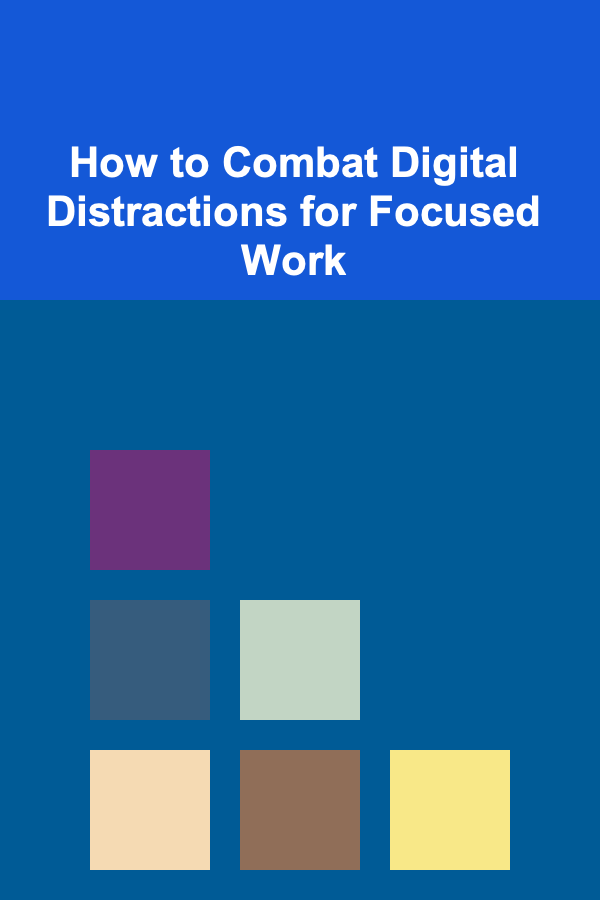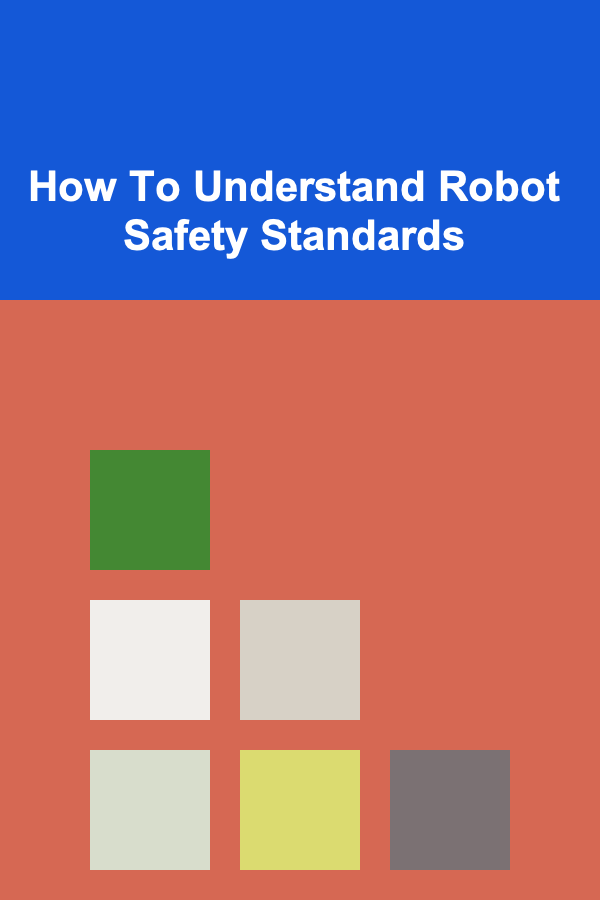
How to Combat Digital Distractions for Focused Work
ebook include PDF & Audio bundle (Micro Guide)
$12.99$9.99
Limited Time Offer! Order within the next:

In today's digital age, distractions are more rampant than ever. The allure of social media, constant notifications, and a myriad of other online distractions has made it increasingly difficult to maintain focus and productivity. Whether you're working from home, in an office, or studying for exams, digital distractions are a significant challenge. However, with the right strategies, it is possible to combat these distractions and regain focus. In this article, we'll explore practical and effective methods for fighting digital distractions and cultivating a focused and productive work environment.
Understanding the Nature of Digital Distractions
Before diving into strategies to combat digital distractions, it's essential to understand what they are and why they are so pervasive.
What Are Digital Distractions?
Digital distractions refer to anything that takes attention away from the task at hand due to electronic devices. This includes smartphones, social media notifications, emails, pop-up ads, or even the temptation to check the news or browse random websites. Digital distractions can interrupt both short-term focus and long-term projects, often leading to procrastination and a sense of wasted time.
The reason these distractions are so potent lies in their ability to hijack our attention. Each notification triggers the brain's reward system, causing the release of dopamine---the "feel-good" neurotransmitter. This creates a cycle where our brains crave more instant gratification from these digital interruptions, making it increasingly difficult to stay focused on less stimulating tasks.
The Impact of Digital Distractions on Productivity
The impact of digital distractions on productivity is profound. Research has shown that it can take up to 25 minutes to return to a task after being interrupted by a notification. This means that every time we check our phone, respond to an email, or scroll through social media, we are wasting valuable time that could be used for deep, focused work.
Furthermore, constant digital distractions contribute to cognitive overload, reducing the quality of our work and the depth of our thinking. The inability to concentrate for prolonged periods leads to stress, frustration, and burnout, as tasks pile up and we feel less in control of our work.
Strategies to Combat Digital Distractions
Now that we understand the nature of digital distractions, let's explore practical strategies to minimize their impact and regain focus.
1. Set Clear Boundaries with Technology
One of the first steps in combating digital distractions is setting clear boundaries with technology. This involves creating a structured environment where you consciously limit your use of digital devices during focused work sessions.
Set Specific Times for Checking Emails and Messages
Instead of constantly checking your email or messaging apps, designate specific times during the day to attend to these tasks. For example, you can check your emails first thing in the morning, around noon, and before the end of the workday. This limits the disruption caused by constant pings and gives you uninterrupted time for focused work.
Turn Off Non-Essential Notifications
Notifications are the primary source of digital interruptions. Whether it's a ping from your social media accounts or a notification from an app, they can break your concentration and derail your workflow. Consider disabling all non-essential notifications on your phone, computer, or tablet. You can either turn off specific app notifications or enable "Do Not Disturb" mode during work hours to minimize distractions.
Use Technology to Help You
Ironically, technology can also be part of the solution. There are a variety of apps and tools designed specifically to help you stay focused and avoid distractions. Some of the most effective tools include:
- Focus apps like Forest or Focus@Will that block distracting websites or apps for set periods, allowing you to focus on your work.
- Time-management apps like Toggl or RescueTime that track how much time you spend on different websites and activities, giving you insight into where your time is going.
- Website blockers like Freedom or Cold Turkey that can block access to distracting websites like social media during your work hours.
2. Create a Distraction-Free Work Environment
Your physical workspace plays a significant role in minimizing digital distractions. A cluttered or disorganized environment can add to cognitive overload and make it more difficult to concentrate. By optimizing your work environment, you can create the perfect conditions for deep work and productivity.
Designate a Specific Workspace
Having a designated workspace---whether it's a corner of your home, a co-working space, or a particular area in your office---helps create a mental boundary between work and leisure. When you enter this space, your brain knows it's time to focus, reducing the temptation to check your phone or wander off task.
Remove Digital Temptations
Minimize distractions by keeping your phone, tablet, and other non-work-related devices out of sight while working. If possible, leave your phone in another room or in a drawer where you can't easily access it. The less visible and accessible these distractions are, the less likely you are to reach for them.
Organize Your Digital Workspace
In addition to your physical workspace, your digital workspace needs organization as well. A cluttered desktop, disorganized files, or multiple browser tabs can cause distractions and decrease your efficiency. Consider using tools like Trello, Notion, or Google Keep to organize your tasks and create a clear structure for your work.
3. Practice Mindfulness and Focus Techniques
Sometimes, overcoming digital distractions requires a mental shift. By training your brain to stay present and focused, you can improve your ability to resist distractions and maintain concentration. Mindfulness and specific focus techniques can help you train your mind to focus for longer periods without succumbing to digital interruptions.
The Pomodoro Technique
The Pomodoro Technique is a time-management method that involves working in short, focused intervals (typically 25 minutes), followed by a short break (5 minutes). After four Pomodoro sessions, take a longer break (15-30 minutes). This method helps maintain focus by breaking work into manageable chunks and creating a rhythm that balances productivity and rest.
Meditation and Deep Breathing
Mindfulness meditation and deep breathing exercises are excellent tools for calming the mind and improving focus. Even taking a few minutes each day to practice deep breathing can help you center yourself, reduce anxiety, and improve your ability to focus. Apps like Headspace or Calm can guide you through mindfulness exercises.
Single-Tasking vs. Multitasking
While multitasking may seem like a productivity booster, it often leads to diminished focus and cognitive overload. Instead, practice single-tasking: focus on one task at a time without jumping between different activities. This allows you to fully immerse yourself in the task at hand, increasing both the quality and efficiency of your work.
4. Build Better Habits for Focused Work
Cultivating habits that support focus and productivity can help you stay disciplined and fight digital distractions over the long term.
Set Clear Goals
Having clear, well-defined goals is crucial for maintaining focus. When you know exactly what you need to accomplish, it's easier to stay on track and avoid distractions. Break down larger projects into smaller, actionable steps and prioritize them according to their importance and deadlines.
Implement a Routine
Establishing a daily routine helps signal to your brain when it's time to work and when it's time to relax. Create a consistent schedule that includes time for focused work, breaks, meals, and relaxation. The more structured your day is, the less likely you are to fall victim to distractions.
Take Regular Breaks
Taking regular breaks is essential for maintaining focus over extended periods. Working for too long without breaks can lead to mental fatigue, which increases the likelihood of digital distractions. Use techniques like Pomodoro or simply take short breaks every hour to stretch, walk around, or relax your mind.
Practice Self-Discipline
Self-discipline is key to fighting digital distractions. While it's tempting to check your phone or open a new tab, remind yourself of your goals and why staying focused is important. Build the habit of resisting instant gratification and prioritize long-term rewards over short-term distractions.
5. Build a Support System
Lastly, don't forget the power of a support system in maintaining focus. Whether it's a colleague, a friend, or an accountability partner, having someone who can encourage and support your efforts to stay focused can make a significant difference.
Set Accountability with a Partner
Share your goals with someone who can check in on your progress. This person can help hold you accountable and provide encouragement when you feel distracted or overwhelmed. Knowing that someone else is tracking your progress can serve as a powerful motivator to stay on task.
Work in Focused Groups
If possible, create or join a group of like-minded individuals who are also working towards the same goal of minimizing distractions and improving focus. Working in a group, even virtually, can help you stay on track, share strategies, and encourage each other.
Conclusion
Digital distractions are an inevitable part of our modern lives, but with the right strategies, we can regain control over our focus and productivity. By setting clear boundaries, creating a distraction-free environment, practicing mindfulness, building good habits, and seeking support from others, we can create a work environment conducive to deep, focused work.
Fighting digital distractions is not about completely eliminating technology from our lives; rather, it's about using technology intentionally and setting boundaries that allow us to focus on what truly matters. By mastering the art of focus, we can improve the quality of our work, reduce stress, and accomplish more in less time.
Reading More From Our Other Websites
- [Scrapbooking Tip 101] From Hobby to Art: Creative Themes for Adult Scrapbooks
- [Home Security 101] How to Install a Home Safe for Added Security
- [Paragliding Tip 101] From Theory to Practice: How Weather Conditions Influence Glide Ratio Optimization
- [Home Maintenance 101] How to Check and Maintain Your Home's Roof Flashing
- [Home Security 101] How to Secure Your Windows and Doors from Break-ins
- [Home Soundproofing 101] How to Soundproof Floors for Quieter Living Spaces
- [Home Maintenance 101] How to Develop a Quarterly Home Maintenance Schedule to Prevent Costly Repairs
- [Personal Care Tips 101] How to Improve Your Flexibility and Mobility as a Baseball Player
- [Home Party Planning 101] How to Create a Fun and Unique Cocktail Menu for Your Party
- [Personal Financial Planning 101] How to Pay Off Debt Faster Without Sacrificing Quality of Life

Earning Passive Income with AI-Powered Chatbots
Read More
How to Start Investing in ETFs (Exchange-Traded Funds)
Read More
How To Understand Robot Safety Standards
Read More
How to Use Options Trading to Hedge Your Investments
Read More
How to Review Horror Films for Suspense
Read More
How to Interpret Blockchain Development Frameworks
Read MoreOther Products

Earning Passive Income with AI-Powered Chatbots
Read More
How to Start Investing in ETFs (Exchange-Traded Funds)
Read More
How To Understand Robot Safety Standards
Read More
How to Use Options Trading to Hedge Your Investments
Read More
How to Review Horror Films for Suspense
Read More